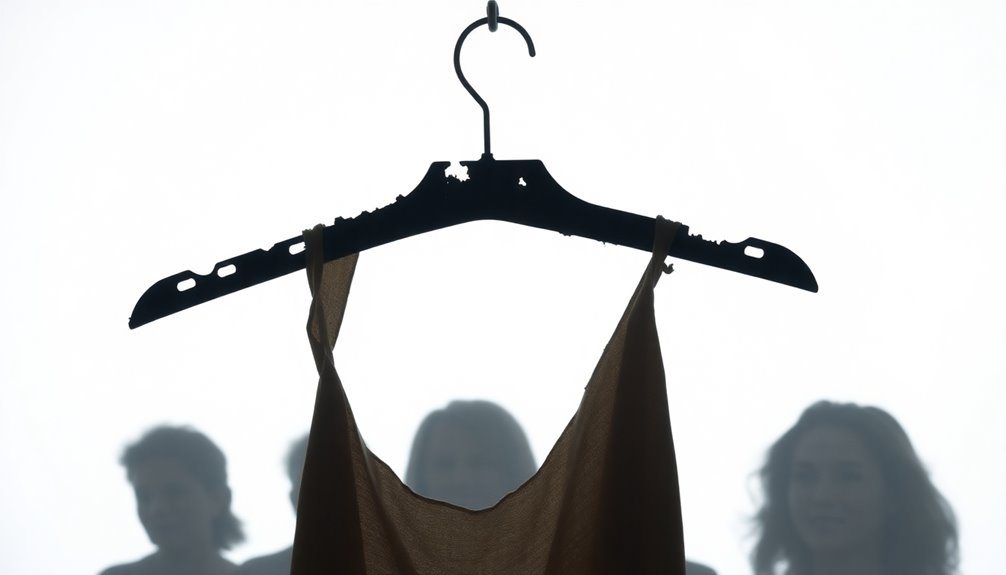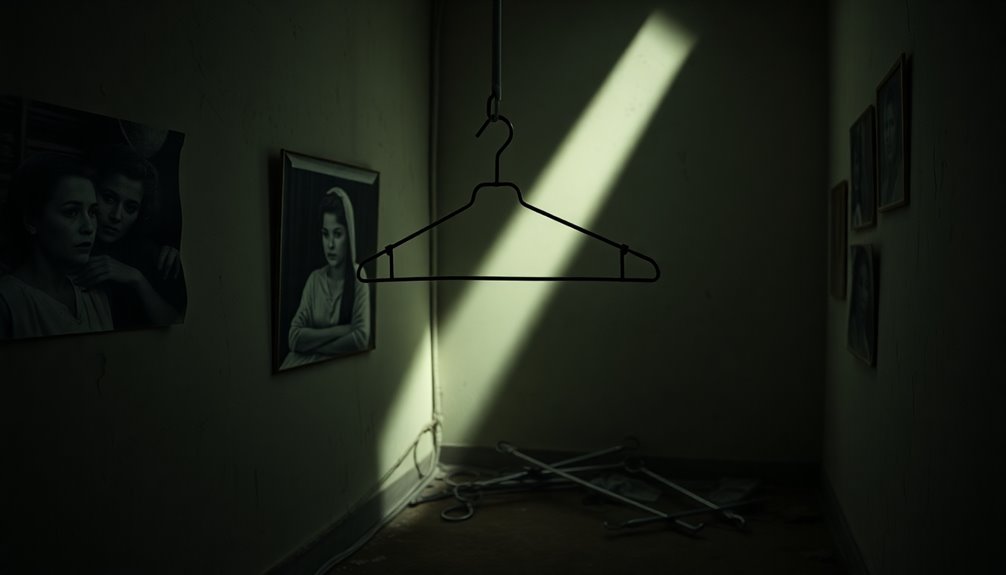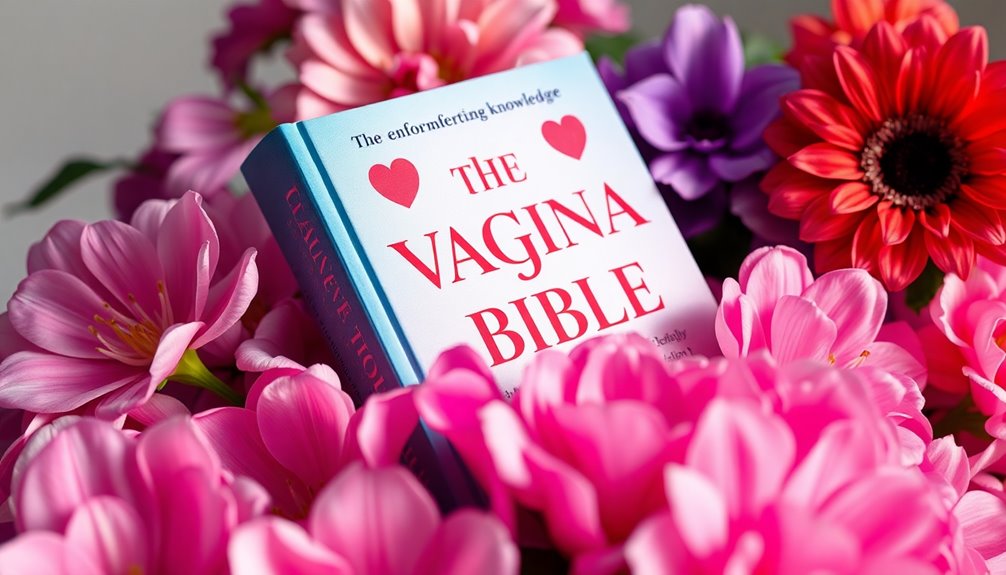Coat hanger abortions reveal a dark side of women's history that schools often overlook. Many women turned to this desperate method during a time when safe abortion access was severely restricted. The risks included severe complications like uterine perforation and lasting health issues. This tragic symbol highlights ongoing inequalities in reproductive rights, especially impacting marginalized communities today. As you explore the current landscape of reproductive health and the urgent need for safe options, you'll uncover the lasting implications of this history and its relevance in today's advocacy for reproductive rights.
Key Takeaways
- Coat hanger abortions emerged from restricted access to safe services, causing severe health complications and long-term effects for women, especially marginalized groups.
- Many illegal abortions were performed by qualified physicians before 1973, indicating significant gaps in healthcare access and reproductive options.
- The coat hanger symbolizes the dangers of unsafe abortion methods, highlighting inequalities linked to gender, race, and class in reproductive health.
- Unsafe abortions remain a leading cause of maternal death, underscoring the critical need for access to safe abortion services.
- Advocacy for comprehensive reproductive care is essential to reduce stigma, promote informed decision-making, and ensure safe options for all individuals.
Historical Context of Coat Hanger Abortions

The historical context of coat hanger abortions reveals a desperate struggle for reproductive rights during times when legal access to safe abortion was severely restricted. Women faced dire circumstances that drove them to use sharp objects like coat hangers, knitting needles, and crochet hooks for self-induced abortions. The lack of legal and safe alternatives often forced them to resort to these dangerous methods, resulting in severe complications such as uterine perforation, hemorrhage, and infections.
Before the advent of modern medical practices, self-induced abortions were common, particularly among those without access to healthcare professionals. Many women turned to midwives, who were often more willing to assist than licensed doctors. This desperation for control over their reproductive choices led to tragic outcomes, as the insertion of sharp objects caused significant health risks, including cramping and excessive bleeding. Medical abortion options have since become a safer alternative, providing individuals with better access to reproductive healthcare.
Despite some historical narratives, most illegal abortions were performed by qualified physicians prior to 1973. The reality of these circumstances highlights the urgent need for safe and legal abortion services, especially for marginalized groups who faced heightened barriers to accessing healthcare.
Symbolism and Its Impact

When you see a coat hanger, it evokes a powerful reminder of the struggles women faced in the fight for reproductive rights during an era of illegal and unsafe abortions. This symbol represents not just desperation but also the profound inequalities tied to gender, race, and class. For many, the coat hanger memorializes those who turned to unsafe methods when their choices were limited. It serves as shorthand for "Never again," igniting urgency in the battle against restrictive abortion laws.
However, critics argue that the coat hanger misrepresents today's reality. Its imagery can feel harmful, especially for those with personal histories tied to unsafe abortions, and it often fails to resonate with younger generations. Many advocates suggest moving towards symbols like abortion pills that reflect safer, clinical options. Legal access to abortion has been shown to correlate with lower maternal mortality rates, emphasizing the need for modern symbols that better represent this context. Focusing solely on the coat hanger overlooks other unsafe methods and the unique challenges faced by people of color in this arena.
Ultimately, while the coat hanger remains a powerful visual in protests, its symbolism needs reevaluation. Highlighting safer alternatives may be more effective for public education and for fostering a comprehensive understanding of reproductive rights today.
Health Risks Before Legalization

Many women faced significant health risks before abortion was legalized, often resorting to unsafe methods like using coat hangers. These sharp objects could easily perforate the soft uterine wall, leading to lacerations of the uterine arteries. If this happened, you could experience severe bleeding, which might be life-threatening without immediate medical attention. The risk of perforation also extended to the vagina, adding further complications to an already dangerous situation.
Using coat hangers wasn't just risky because of physical injuries; infection loomed large as well. Since these objects weren't sterile, introducing bacteria during self-abortion could result in septic abortions. If untreated, these infections could escalate to septic shock, increasing the chances of death. The potential for hemorrhage due to uterine perforation compounded the dangers; many women attempted these procedures alone, lacking access to emergency care. Unsafe abortions often led to long-term health complications, including infertility, highlighting the dire need for safe and legal reproductive options.
Current Reproductive Landscape

In today's reproductive landscape, access to abortion care varies dramatically across the United States, shaped by a patchwork of state legislation and policies. You'll find that 13 states have made abortion illegal, while 28 enforce bans based on gestational duration. This means you might face a ban at or before 18 weeks in seven states, or after in 21 others. The situation has led to a doubling of interstate travel for abortion care from 2020 to 2023, but this isn't easy for everyone. Financial and logistical barriers prevent many from accessing the care they need. With donations to abortion funds dwindling, many people find themselves in abortion deserts, where options are limited. The impact of these restrictions is most severe on poor women and women of color, who often face the brunt of these policies. Self-induced abortions are on the rise, highlighting the desperate measures some resort to in response to restricted access. In response, protective states may innovate to support reproductive health, while restrictive states tend to reinforce their bans. This uneven landscape underscores the urgent need for advocacy and reform in reproductive rights across the nation. Abortion rights measures in states like Florida have struggled to meet constitutional amendment thresholds, reflecting the challenges advocates face in combating restrictive policies.
Critiques of the Coat Hanger Symbol

Critiques of the coat hanger symbol often highlight its historical inaccuracies and emotional weight, prompting a reevaluation of its place in contemporary abortion advocacy. While it's meant to represent the dangers of illegal abortions, most were conducted by trained abortionists rather than through self-induced methods. This misrepresentation overlooks the more complex and dangerous techniques used at the time, like injecting fluids or utilizing abortifacient remedies.
Moreover, the imagery can evoke trauma for those with personal histories of unsafe abortions, which might alienate rather than unite advocates. The simplicity of the coat hanger can trivialize the real suffering experienced, particularly among marginalized communities who face ongoing disparities in healthcare access. Additionally, historical data indicates that high mortality rates from unsafe abortion methods highlight the severe consequences women faced before legal options became available.
Using the coat hanger may unintentionally aid anti-abortion narratives, suggesting that unsafe methods are the only alternatives to legal abortion. This focus diverts attention from the safe and legal options available today. As advocacy evolves, it's crucial to embrace symbols that reflect current realities and promote knowledge about modern abortion care. Advocates suggest moving beyond this outdated symbol to foster a more inclusive and informed dialogue about reproductive justice.
Advocating for Safe Options

Advocating for safe abortion options is crucial in ensuring that individuals can make informed choices about their reproductive health. Understanding the various safe methods available empowers you to take control of your situation. Medication abortion, involving mifepristone and misoprostol, is effective up to 12 weeks and can be done at home with telemedical support. If you're beyond that timeframe, in-clinic options like vacuum aspiration or dilation and evacuation (D&E) are performed by trained professionals and are safe up to 14-16 weeks and later, respectively.
Following World Health Organization (WHO) guidelines, these methods are designed to minimize complications. In fact, medical abortions are effective 97% of the time when used correctly, and suction abortions are safer than dental procedures. You're also more likely to face severe risks during childbirth than from an abortion. Unsafe abortion is a leading cause of maternal death, highlighting the importance of accessing safe services.
Accessing comprehensive care, including necessary tests and follow-up consultations, is vital. With telemedicine, you can reduce waiting times and receive professional guidance on the risks, benefits, and post-procedure birth control options. By advocating for safe options, you're not just protecting your health; you're also supporting a system that prioritizes informed, safe choices for everyone.
Frequently Asked Questions
What Specific Methods Were Used for Illegal Abortions Before Legalization?
Before abortion was legalized, various methods were used, often in dangerous conditions. Physicians sometimes performed these procedures, but many women turned to nonmedical practitioners or attempted self-induced abortions using unsafe instruments like wire hangers. You might find herbal remedies being used, with women resorting to risky practices to avoid detection. The lack of safe options pushed many into clandestine networks, risking their health and lives for a choice that should've been safe and accessible.
How Did Coat Hanger Abortions Affect Different Demographics?
Coat hanger abortions severely impacted various demographics, especially low-income individuals and communities of color. You might find that those in these groups often lacked access to safe and affordable healthcare, forcing them to resort to dangerous methods. Rural residents faced additional barriers due to limited facilities, while LGBTQ+ individuals dealt with stigma and discrimination. All these factors made unsafe abortions more prevalent, highlighting the urgent need for equitable reproductive healthcare access for everyone.
What Legal Changes Followed Roe V. Wade Regarding Abortion Access?
After Roe v. Wade in 1973, you saw significant changes in abortion access. The ruling recognized abortion as a constitutional right, allowing for more regulation as pregnancy progressed. However, the landscape shifted dramatically with its overturning, enabling states to impose bans. Now, you might find yourself in an "abortion desert" where access is severely limited, facing numerous restrictions that disproportionately affect marginalized communities and complicate the journey to obtain necessary care.
How Can Individuals Support Reproductive Rights Today?
You can support reproductive rights today by advocating for legislation that protects and expands access to abortion. Engage with social media to share accurate information and personal stories, helping to counteract misinformation. Get involved in grassroots movements and support organizations fighting for reproductive justice. Additionally, educate yourself and others about comprehensive reproductive health options, and participate in community efforts to ensure marginalized voices are heard and represented in policy discussions.
What Resources Exist for Individuals Seeking Safe Abortion Options?
If you're seeking safe abortion options, there are several valuable resources available. You can use INeedAnA to find nearby clinics and telemedicine options. Websites like AbortionFinder.org provide a directory of trusted providers. For financial assistance, check out the National Network of Abortion Funds. If you need emotional support, consider calling the All Options Talkline. These resources can help you navigate your choices and ensure you receive the care you need.
Conclusion
In understanding the dark history of coat hanger abortions, you're reminded of the importance of safe, legal options for all. This symbol represents not just pain and loss, but a call to action for reproductive rights. By advocating for comprehensive education and access to healthcare, you can help ensure that no one has to face such dangerous choices again. Let's work together to create a future where everyone has the right to make safe reproductive decisions.









